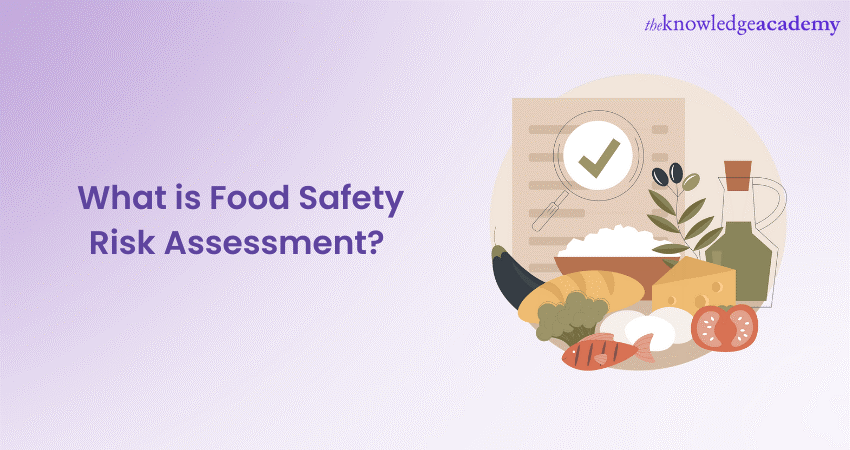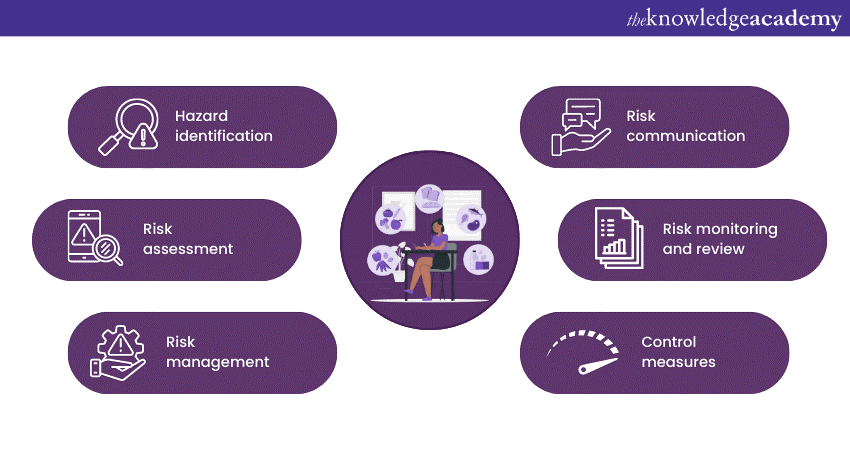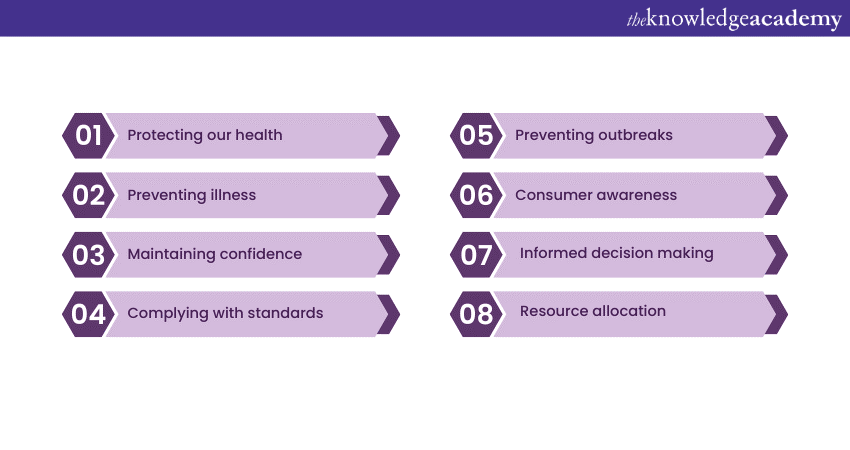We may not have the course you’re looking for. If you enquire or give us a call on 01344203999 and speak to our training experts, we may still be able to help with your training requirements.
Training Outcomes Within Your Budget!
We ensure quality, budget-alignment, and timely delivery by our expert instructors.

We are living in a rapidly evolving world where food is sourced globally. As culinary preferences span across cuisines, ensuring Food Safety has taken centre stage. It is no longer sufficient to merely savour the flavours. We must also be confident that what we eat won't compromise our well-being. This is where Food Safety Risk Assessment steps in as a crucial guardian of our health and the integrity of the food industry.
Though assessing risks related to food is crucial, it involves more than systematically identifying potential risks within the food production and distribution chain. In this blog, you will explore the Food Safety Risk Assessment, its significance, and the processes involved. We will also discuss the major components that make it an indispensable tool in safeguarding our plates and our health.
Table of Contents
1) What is a Food Safety Risk Assessment?
2) Preparing for your Risk Assessment
3) Key components of Food Safety Risk Assessment
4) Importance of Food Safety Risk Assessment
5) Case study: Salmonella outbreak in ready-to-eat meals
6) Conclusion
What is Food Safety Risk Assessment?
Food Safety Risk Assessment is a systematic process that focuses on the safety of the food we consume. It involves thoroughly examining the food to identify any potential risks that could negatively affect our health. This process involves gathering information about various types of hazards that might be present in our food.
Consider a meal, such as a chicken sandwich. Within this meal, there could be factors that pose a threat to our well-being. For instance, the chicken might not have been cooked properly, or there could be harmful bacteria on the lettuce. These elements, which can cause harm, are the primary concerns of the risk assessment.
The assessment evaluates the likelihood of these hazards causing harm and the potential quantity of exposure. If there's a high possibility that consuming the sandwich could result in illness, it's a significant concern. Also, if the chances of harm are minimal, the worry is reduced.
However, identifying risks isn't the sole purpose of the assessment. It also devises strategies to mitigate these risks, much like devising a safety plan. For example, it might recommend cooking the chicken at a specific temperature or washing the lettuce thoroughly to eliminate potential hazards.
Preparing for your Risk Assessment
Before you start the Food Safety Risk Management process, it's important to clearly define what will be assessed. Here's how you can prepare for Food Safety Risk Assessment:
a) Scope: Determine the extent of the assessment, including processes, activities, functions, and physical locations. Clearly outlining the scope helps in planning and budgeting by specifying what's included and what's not.
b) Resources: Identify the resources necessary for conducting the Risk Assessment, such as time, personnel, and financial resources. These are essential for developing, implementing, and managing the assessment effectively.
c) Stakeholders: Involve all relevant parties in the Food Safety Risk Assessment process, including senior leaders and an assessment team. Designate key roles like Risk Management Manager, assessment team leader, assessors, and subject matter experts to ensure effective collaboration.
d) Laws and regulations: Understand the specific regulations and legal requirements applicable to your industry, such as those enforced by organisations like OSHA. Ensure that the assessment aligns with these regulations to maintain compliance within your organisation.
Elevate Your Food Safety expertise with our Food Safety Manager and Supervisor Masterclass - join now!
Key components of Food Safety Risk Assessment
Food Safety Risk Assessment involves several important steps that work together to keep our food safe to eat. Let's break down these steps into simple terms:

Hazard identification
Hazard identification is the starting point of Food Safety Risk Assessment. This phase involves identifying potential sources of harm in our food. It involves creating a checklist of possible dangers, such as harmful bacteria, chemicals, or foreign objects that could negatively impact our health. By listing these hazards, we can lay the foundation for further analysis and control.
Risk Assessment
Once hazards are recognised, the Food Safety Risk Assessment assess the probability and severity of harm they might cause. It's a systematic evaluation that identifies the potential risk. Think of it as a careful examination of how serious those hazards are. This assessment provides a clear picture of the level of risk associated with different hazards.
Risk Management
Building upon the insights from the Food Safety Risk Assessment, Risk Management focuses on devising strategies to mitigate or eliminate identified risks. This step involves creating plans, protocols, and measures to prevent harm. By implementing safety measures, setting guidelines, and following best practices, risk management ensures that potential threats are kept under control.
Risk communication
Risk communication involves sharing the findings of the Food Safety Risk Assessment and the strategies of risk management with relevant stakeholders. This step ensures that everyone involved, from consumers to producers, is informed about potential hazards and the measures in place to tackle them. Clear and open communication promotes understanding and cooperation, contributing to overall Food Safety.
Risk monitoring and review
Risks in the food industry can change over time. Risk monitoring and review are like continuous checks to ensure that the established risk management strategies are effective. Regular monitoring helps detect any shifts in hazards or their impacts. If changes are identified, adjustments can be made to maintain the efficacy of risk management measures.
Control measures
Control measures are practical steps taken to guarantee the safety of our food. They are like a set of rules and guidelines that act as safeguards against potential risks. These measures are put in place to ensure that the food we consume is free from harmful contaminants and safe for our health.
Here are Food Safety Questions and Answers You Should Go Through Before your Interview.
Importance of Food Safety Risk Assessment
Food Safety Risk Assessment plays a vital role in safeguarding our health and well-being. It ensures that the food we eat is safe and free from potential dangers. Let's explore why this process is so important:

Protecting our health
The primary reason for Food Safety Risk Assessment is to keep us healthy. By identifying and managing potential hazards in our food, we can avoid consuming substances that could cause illness or harm.
Preventing illness
Assessing Food Safety risks helps prevent foodborne illnesses. It stops harmful bacteria, viruses, and other contaminants from reaching our plates, reducing the likelihood of stomach upsets or more severe health issues.
Maintaining confidence
When we know that the food we're eating has been thoroughly checked for safety, our confidence in the food supply increases. This trust is essential for both consumers and the food industry.
Complying with standards
Food Safety Risk Assessment ensures that food products meet the standards set by regulatory authorities. This compliance is crucial to maintain the quality and safety of the food supply.
Preventing outbreaks
By identifying potential hazards before they become widespread, risk assessment helps prevent large-scale outbreaks of foodborne illnesses. Quick action can be taken to remove contaminated products from the market.
Consumer awareness
When Food Safety risks are communicated transparently, consumers are empowered to make informed choices. They can take steps to eliminate their exposure to risks, such as by properly cooking food or avoiding certain products.
Informed decision making
Food producers and regulators use the information from risk assessments to make decisions about food production, distribution, and safety measures. This data-driven approach helps improve overall Food Safety.
Resource allocation
Resources can be allocated more effectively when risks are identified and prioritised. This prevents unnecessary expenses and efforts on less critical risks, focusing attention where it's most needed.
Elevate Food Safety standards with Food Hygiene And Safety In Manufacturing Training. Join now!
Case study: Salmonella outbreak in ready-to-eat meals
Let's take a closer look at a case study involving a Salmonella outbreak linked to ready-to-eat meals. This incident highlights the importance of thorough Food Safety Risk Assessment and the critical role it plays in protecting public health:
Background
Ready-to-eat meals have become increasingly popular due to their convenience. However, this convenience comes with risks, as these meals are often handled and prepared by various parties before reaching consumers. In this case study, the focus is on a series of events that unfolded when a Salmonella outbreak was traced back to such meals.
Hazard identification
The investigation began with identifying the hazard – Salmonella bacteria. This bacterium is notorious for causing foodborne illnesses, with symptoms ranging from mild gastroenteritis to severe cases requiring hospitalisation. Identifying this hazard was crucial in understanding the root cause of the outbreak.
Risk Assessment
Once the hazard was identified, the Food Safety Risk Assessment process swung into action. Experts evaluated the risks associated with the Salmonella contamination. They examined how likely it was for the bacteria to survive, grow, and potentially cause illness in the ready-to-eat meals. The assessment also considered the vulnerability of the target population.
Exposure Assessment
To understand the exposure potential, investigators delved into the consumption patterns of the affected ready-to-eat meals. They gathered data on how many people consumed the contaminated products, how frequently they did so, and the portion sizes. This information allowed them to estimate the extent of exposure to the hazard.
Control measures and mitigation
Once the risks were assessed, control measures were implemented to mitigate the outbreak's impact. This involved identifying the source of contamination, recalling affected products from the market, and improving hygiene practices across the food supply chain. Additionally, consumers were advised to avoid the specific products and practice safe food handling at home.
Monitoring and lessons learned
Following the outbreak's containment, a monitoring phase kicked in. Public health agencies closely monitored new cases to ensure that the control measures were effective. This phase also provided an opportunity to examine the incident and identify areas for improvement in the food supply chain and risk assessment processes.
Take the next step in Food Safety skills. Join the Food Allergy Awareness Masterclass today!
Conclusion
Food Safety Risk Assessment is a crucial process that safeguards the safety and quality of the food we consume. By identifying, evaluating, and mitigating potential hazards, we can prevent foodborne illnesses, protect public health, and maintain consumer trust.
Enhance workplace safety with our Food Safety Masterclass - sign up now for expert insights!
Frequently Asked Questions

A career in food safety risk assessment typically requires a degree in food science, microbiology, or a related field. Additionally, certifications like HACCP or Food Safety Management are often needed. Practical experience and knowledge of food regulations are valuable too.

Experience in Food Safety Risk Assessment enhances career advancement by demonstrating expertise in ensuring food safety, compliance with regulations, and mitigating risks. It improves employability, opens doors to higher-level positions, and fosters trust from employers and stakeholders.

The Knowledge Academy takes global learning to new heights, offering over 30,000 online courses across 490+ locations in 220 countries. This expansive reach ensures accessibility and convenience for learners worldwide.
Alongside our diverse Online Course Catalogue, encompassing 17 major categories, we go the extra mile by providing a plethora of free educational Online Resources like News updates, Blogs, videos, webinars, and interview questions. Tailoring learning experiences further, professionals can maximise value with customisable Course Bundles of TKA.

The Knowledge Academy’s Knowledge Pass, a prepaid voucher, adds another layer of flexibility, allowing course bookings over a 12-month period. Join us on a journey where education knows no bounds.

The Knowledge Academy offers various Health & Safety in the Workplace Courses, including the Food Safety Training and Healthy Working Environment Training. These courses cater to different skill levels, providing comprehensive insights into the Importance of Health and Safety.
Our Health & Safety Blogs cover a range of topics related to Workplace Safety, offering valuable resources, best practices, and industry insights. Whether you are a beginner or looking to advance your Workplace Safety skills, The Knowledge Academy's diverse courses and informative blogs have you covered.
Upcoming Health & Safety Resources Batches & Dates
Date
 Food Safety and Hygiene Course
Food Safety and Hygiene Course
Fri 3rd Jan 2025
Fri 7th Mar 2025
Fri 2nd May 2025
Fri 4th Jul 2025
Fri 5th Sep 2025
Fri 7th Nov 2025







 Top Rated Course
Top Rated Course



 If you wish to make any changes to your course, please
If you wish to make any changes to your course, please


